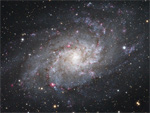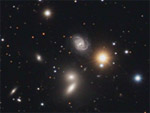Astrophotography by Bernhard Hubl |
||||||||||||||||||||||||||||||||||||||||||||||||||||||||||||||||||||||||||||||
|
GalaxiesA galaxy is a massive, gravitationally bound system consisting of stars, an interstellar medium of gas and dust, and dark matter. Typical galaxies range from dwarfs with as few as ten million stars up to giants with one trillion stars, all orbiting a common center of mass. A typical galaxy belongs to one of the following three classes:
1.Spiral galaxies: Spiral galaxies consist of a
flat, rotating disk of stars, gas and dust, and a central concentration of
stars known as the bulge. These are surrounded by a much fainter halo of
stars, many of which reside in globular clusters. 2. Elliptical galaxies: Elliptical galaxies have smooth,
featureless light-profiles and range in shape from nearly spherical to
highly flattened, and in size from hundreds of millions to over one
trillion stars. In the outer regions, many stars are grouped into globular
clusters. Most elliptical galaxies are composed of older, low-mass stars,
with a sparse interstellar medium and minimal star formation activity. An irregular galaxy is a galaxy that does not fall into any of the regular classes of the Hubble sequence. These are galaxies that feature neither spiral nor elliptical morphology. They are often chaotic in appearance, with neither a nuclear bulge nor any trace of spiral arm structure.
A dwarf galaxy is a small galaxy composed of up to several billion stars, a small number compared to our own Milky Way's 200-400 billion stars. Galaxies are usually not isolated, but form gravitationally-bound groups and clusters.
|
|||||||||||||||||||||||||||||||||||||||||||||||||||||||||||||||||||||||||||||


